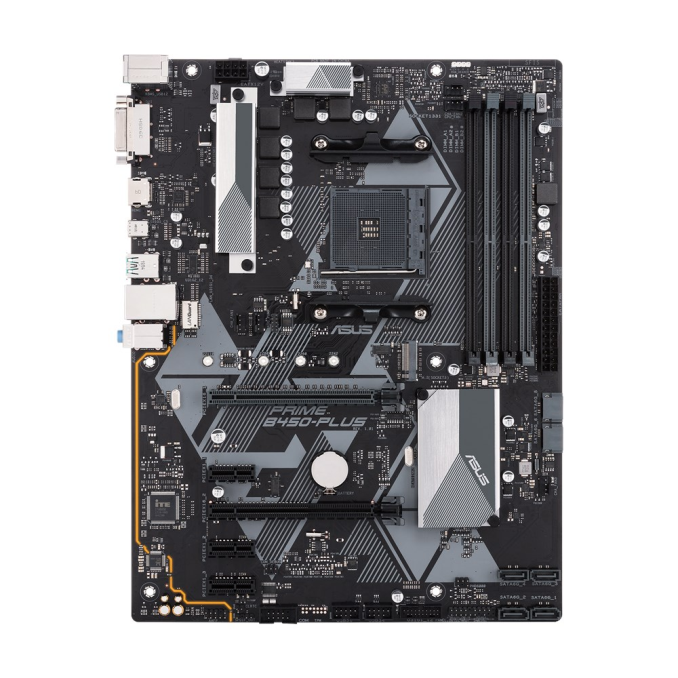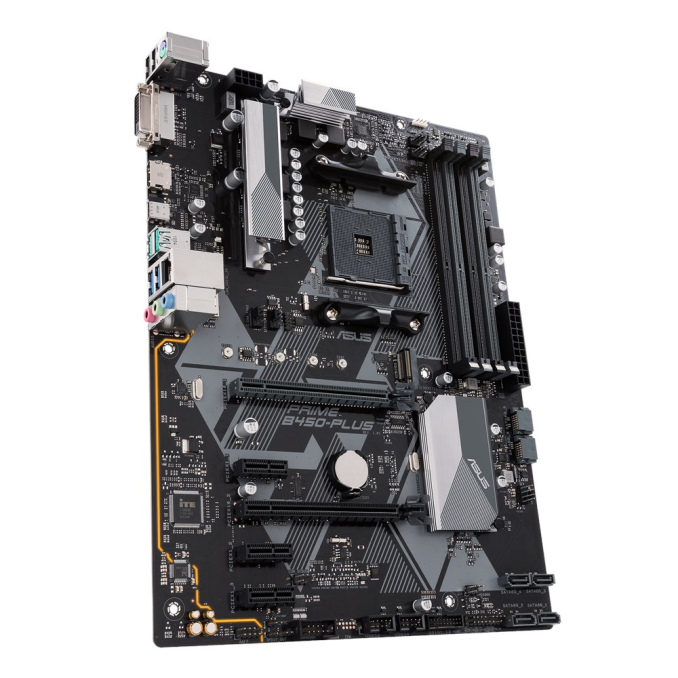Analyzing B450 for AMD Ryzen: A Quick Look at 25+ Motherboards
by Gavin Bonshor on July 31, 2018 8:00 AM ESTASUS Prime B450 Plus
Although the TUF and Prime brands from ASUS share similar pricing schemes with their low-cost entry-level options, the TUF series is aimed specifically for gamers, whereas the Prime range shifts to a more basic and subtle range of features and aesthetics. The ASUS Prime B450-Plus provides a solid infrastructure to build a solid and good value system upon. The main features of the Prime B450-Plus include a Realtek ALC887-VD2 audio codec with an entry to DDR4-3200 memory support at a low base price.
The aesthetics of the Prime B450-Plus ATX motherboard come through a subtle and clean looking black PCB with grey print which resembles a triangle pattern. The heatsinks across the board feature a classic looking light metallic finish, with a contrasting shade of darker grey to give extra definition. While there are no LEDs embedded into the PCB of the motherboard, a single Aura Sync-enabled RGB header is present to allow for users looking to add at least some element of RGB to their system.
In terms of PCIe, the board has two full-length PCIe slots with the top (grey) slot having a PCIe 3.0 x16 interface, and the second slot (black) taking its bandwidth directly from the B450 chipset, giving it an operational specification of PCIe 2.0 x4. In addition, a further three PCIe 2.0 x1 slots are there to give support for adapter cards such as sound cards and additional networking controllers etc.
The board has a total of four memory slots capable of supporting DDR4-3200, with a maximum capacity across the available slots of up to 64 GB. Both non-ECC and ECC memory are supported, with the latter entirely dependent on the used processor's capability to do so.
Providing power to the motherboard on the right-hand side of the board is a 24-pin ATX power input and between the corners of the MOSFET heatsinks is a single 8-pin ATX 12 V power input to provide power to the CPU. ASUS also advertises a 6-phase Digi+ digital power delivery on the B450-Plus Prime motherboard which is standard across their low-mid range (non-ROG branded) B450 chipset models.
Making up the storage is a total of six SATA 6 Gbps ports with four of them featuring straight angled connectors, whereas the remaining two located below the 24-pin ATX motherboard power input is right-angled. As with all of the B450 motherboards at launch, the SATA 6 Gbps ports support RAID 0, 1 and 10 arrays. A single M.2 slot is located just above the top full-length PCIe 3.0 x16 slot and has support for both SATA and PCIe 3.0 x4 M.2 22110 (22 x 110 mm) SSDs.
In relation to cooling options, the Prime B450-Plus has a total of five 4-pin headers with them being split between three different sections; three for case fans, one dedicated to the CPU fan and one for use with an AIO CPU cooling pump. A clear CMOS jumper is located towards the bottom PCIe 2.0 x1 and there’s capability to expand the featured USB connections by a further two USB 3.1 5 Gbps and four additional USB 2.0 ports thanks to internal headers.
The rear panel on the Prime B450-Plus is a variety of connections including two USB 3.1 10 Gbps Type-A ports, two USB 3.1 5 Gbps Type-A ports, two USB 2.0 ports and a single USB 3.1 5 Gbps Type-C port. Also features is three 3.5mm audio jacks with the onboard audio being powered by the Realtek ALC887-VD2 audio codec, and the single LAN port being handled by a Realtek RTL8111H Gigabit networking controller. To make use of the Ryzen 2000 series APUs is an HDMI and DVI-D output, with a single PS/2 keyboard/mouse combo port finishing off the rear I/O.
While the Prime range is a relatively basic and standard foundation to create a new system, the limitations are on the rest of the components and not the motherboard itself. The Prime B450-Plus looks good for a user not looking for anything too fancy, without paying extra for premium controllers such as the Realtek ALC1220 audio codec; the launch pricing of $109.99 signifies the intent to offer decent quality at a low entry price.





_thumb.png)
_thumb.png)
_thumb.png)
_thumb.png)
_thumb.png)
_thumb.png)








62 Comments
View All Comments
sh009vf5ik1a - Saturday, January 18, 2020 - link
Heads up on the Gigabyte B450 DS3H...This article pretty clearly states ECC memory is supported on this board, and so does Gigabyte's product page, however it fails to mention that 'supported' means just boot support. The actual Error Checking and Correction features are missing and unable to be leveraged.
I purchased this board purely based on this article for the sole reason of having a cheap ECC setup. Combined it with a Ryzen 2600 and Unbuffered Kingston ECC memory, and found that its impossible to get ECC working.
The system boots and works, but you do not get ECC functionality.
chrcoluk - Monday, August 30, 2021 - link
I read on reddit someone wrongfully stated the 2nd 16x slot is only pci gen 2. I wondered how they got this info, I then came across this review, which also states the 2nd 16x slow is gen 2.According to the manual both slots are gen 3 and both are hooked to the cpu.
I have confirmed this as I now use an asmedia 1604 sata card, on post it reports what pci-e mode its in, if I use any of the x1 slots it reports gen 2 x1, if I use either of the x16 slots it reports gen 3 x1 (its limited to one lane). I actually have even moved the gpu to the second x16 slot as its easier to plug in cables to the sata card when its in a higher slot and even gpuz reports the gpu is on pcie gen 3.
Whats the lesson? read the manual, test and dont take what a media rep tells you for gospel ;)